How Three Passionate Designers Made History at the U.S. Air Force
Maureen Stewart, a 10-year U.S. Air Force veteran, shares how one question from a team member led to the creation of an unexpected series of inspiring posters shared around the world.
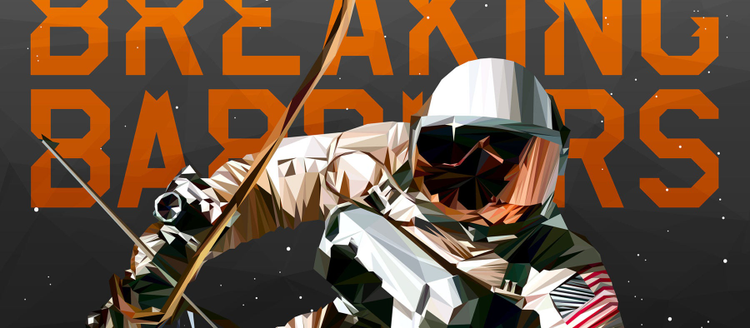
Maureen Stewart / Breaking Barriers / 1965 Spacewalk by Major Edward H. White.
Apply to the Adobe Government Creativity Awards here.
See the making of ‘The First Spacewalk’.
“I love my Air Force. It’s the reason I came back to it. It’s where I want to be.”
That’s what Maureen Stewart, a designer for Airman Magazine, said when we asked what drove her and her team to push above and beyond on a project celebrating the United States Air Force on its 70th birthday.
Maureen served in the Air Force for 10 years before joining civilian life as a designer outside Washington, D.C.
She served in several roles before seeing an opportunity at Airman Magazine, the official magazine of the Air Force. She jumped at the chance to rejoin who she warmly refers to as her “family.”
The opportunity — zag when everyone zigs
The original request Maureen and her team received was to create a website to celebrate the 70th birthday of the Air Force.
It was an opportunity to pay tribute to the innovation and service of thousands of men and women over the years. The creative team was asked to show the organization’s history on the new website.
The team agreed, but one of the designers, Travis Burcham, also pitched something a little different to add to the list: a poster series.
“We wanted to create a really cool series of posters that could be printed and used by anyone — where the artwork on each poster would artistically show a pivotal time in the Air Force’s history,” said Maureen.
“It could represent an innovation, a milestone, a person, or a major event that made a lasting and positive impact in the world — to help us all remember,” she said.
The inspiration
In the 1980s, a series of posters came out to represent what the future could hold for the Air Force. Printed artwork like these was created for decades — and it was common for civilians to display these posters with pride.
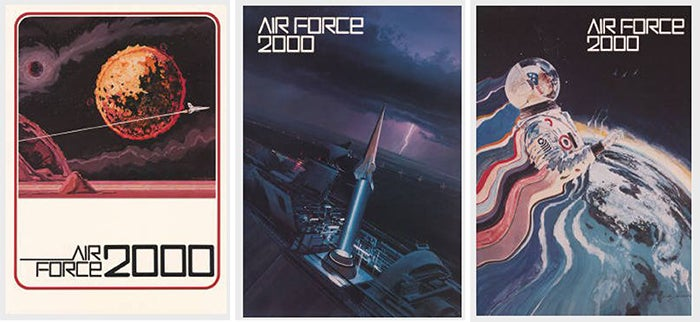
Someone on the team found these old posters and asked, “Why aren’t we doing this now?” That one question led Maureen’s team to create their poster series.
But while in the 1980s, posters were available only in print, the new series of high-resolution images could also be downloaded for viewing on screens.
The goal of the project
The team’s mission was to tell the U.S. Air Force’s story in a dynamic, different, and interesting way.
“Sometimes, you need to show (not just tell) to get the great, out-of-the-box ideas out there.”
“The Air Force is the youngest service here in the U.S., so being able to showcase strong moments and people in our history to represent how far we have come was very important,” said Maureen.
The challenge
Projects in the military can be very regimented and structured, with many people involved with approvals and changes.
“If you have a great idea and you’re not sure how it’s going to be received, just make it and present it. Show your capabilities. Saying you can do something is not enough. Show them,” Maureen said.
She and her team took a leap of faith that their approach to these posters would be well received.
“We didn’t reach out for guidance throughout the process, and instead let our designers have the freedom to create what they believed was imaginative, different, and engaging,” she said.
“We were so passionate about the project that we spent many extra hours of our own time in making it perfect.”
The creative process
In her words, Maureen takes us through her design process:
- The style. Originally, we talked about making all the posters look the same, but then we decided to give them unique elements, so each designer could express their own style. I decided to go with a low-poly look, piecing together geometric shapes to recreate images.
- Research. So much of it was research, looking through the decades for big events. Finding what was important, then choosing how to depict it artistically. As designers of this project, we all had a ton of fun. We all learned really cool and bizarre U.S. Air Force facts.
- Sketches. Paper, pencil, sketching by hand for composition.
- Design. Adobe Illustrator — my go-to. My bread and butter for everything.
- Capture behind-the-scenes coverage. Adobe Premiere — to edit the time-lapse videos.
- Repeat.
After we created individual posters for each decade, we decided to do something different for our final poster. We designed something that represented the future of the Air Force. For me, that was something that doesn’t exist yet but is in development. This allowed us to explore new technology and think about where the Air Force is headed.
End to end, it took our team about a year to create all of the posters. The first set of posters was released in January 2017, and from there, we released three posters per month.
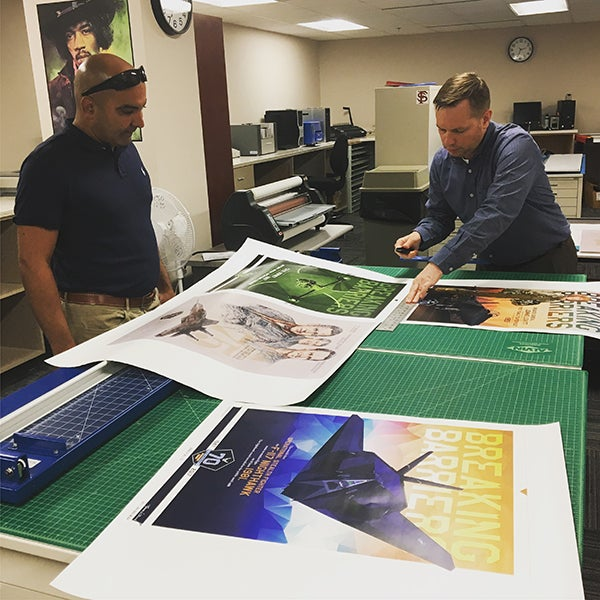
The results
The posters were received with a great amount of enthusiasm by the U.S. Air Force.
“Approvals were effortless compared to most things we do,” Maureen said. “A big part of that was that we weren’t putting out any new messaging. We were presenting facts that were readily available, and visually showing them in creative, modern, and engaging ways.”
“Before I knew it, I was getting text messages with photos of our posters hung up all over the world. They are hanging now in the Pentagon and at a base in Kuwait.”
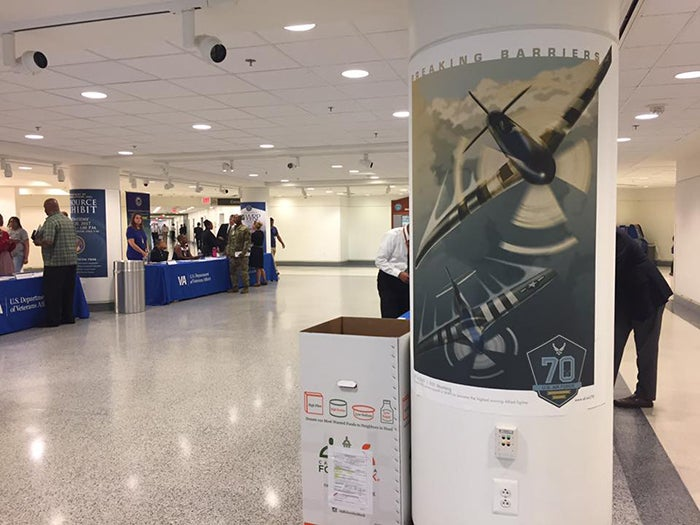
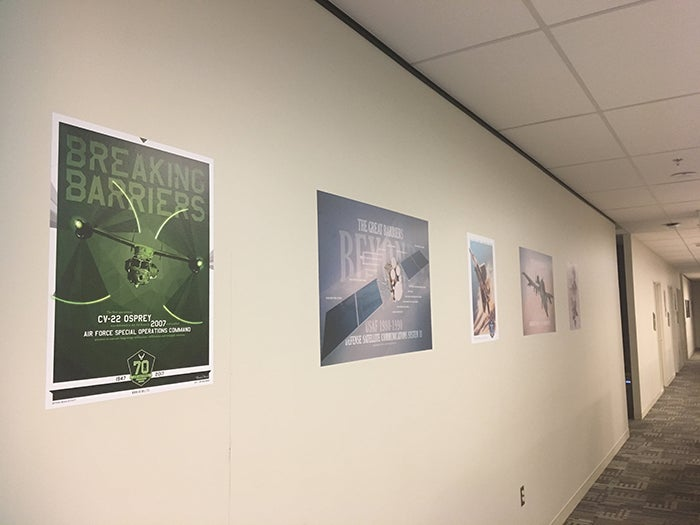
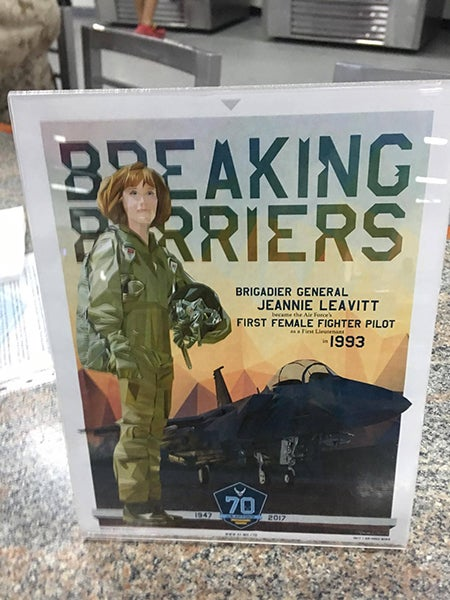
Read more in our Creating Impact series.
The team behind the Breaking Barriers project:
- Corey Parrish, team lead.
- Brandon DeLoach, web designer.
- Maureen Stewart, Chris Desrocher, Travis Burcham, poster designers.
See all three designers’ posters here:
https://www.behance.net/gallery/65484351/Breaking-Barriers-the-Air-Force-turns-70